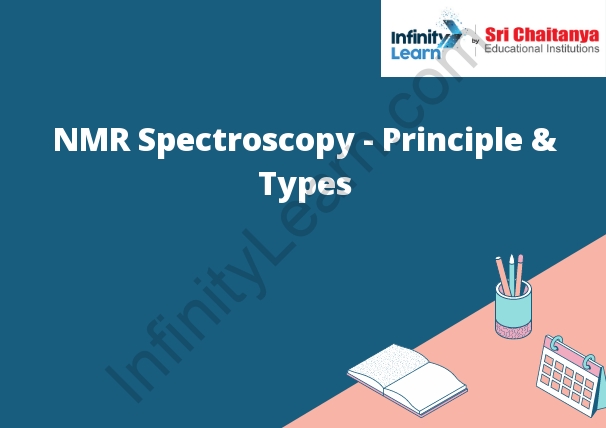Table of Contents
NMR Spectroscopy
NMR Spectroscopy – Principle & Types: NMR spectroscopy is a technique that is used to study the structure and dynamics of molecules. This technique uses the magnetic properties of nuclei to generate a spectrum that can be used to determine the structure of a molecule. The spectrum is generated by sending a pulse of energy to the molecule and then measuring the response of the nuclei. This technique can be used to determine the structure of a molecule, the dynamics of a molecule, and the interaction of molecules.

What is NMR-Spectroscopy?
Nuclear magnetic resonance spectroscopy (NMR) is a technique used to determine the structures of molecules. NMR spectroscopy exploits the fact that certain types of atoms, such as hydrogen, have a nuclear spin. This spin can be aligned in different directions by applying a magnetic field. When the atom is in a magnetic field, it behaves like a small magnet. The direction of the nuclear spin can be determined by measuring the radiofrequency signal that is emitted by the atom. By varying the direction of the magnetic field, different types of atoms in a molecule can be selectively excited. This allows the structures of molecules to be determined.
What is NMR?
Nuclear magnetic resonance spectroscopy (NMR) is a technique used to determine the structure of molecules. It exploits the fact that certain nuclei, such as hydrogen, have a magnetic moment. When placed in a magnetic field, these nuclei will precess around the field at a frequency that is specific to the molecule. By measuring the frequency of the precession, the structure of the molecule can be determined.
NMR-Spectroscopy Principle
Nuclear magnetic resonance spectroscopy (NMR) is a technique used to determine the structures of molecules. It works by detecting the nuclear magnetic moments of the atoms in a molecule. These moments are affected by the magnetic fields around the atoms. NMR spectroscopy uses the frequency of the radiation that is absorbed or emitted by the atoms to determine the structure of the molecule.
NMR-Instrumentation –NMR-Spectrometer
- The NMR-spectrometer is the basic instrument for NMR-spectroscopy. It is a device that uses a strong magnetic field and radio-frequency pulses to measure the response of nuclear magnetic moments to a magnetic field.
- The NMR-spectrometer has a main console with a screen, on which the spectrum is displayed, and a number of knobs and buttons to control the instrument. There is also a computer interface to allow the user to control the instrument and to save and analyze the spectra.
- The instrument consists of a strong magnet, which produces a magnetic field of about 1.5 tesla. This field is used to orient the nuclear magnetic moments of the molecules in the sample. The sample is placed in a glass tube, which is placed in the center of the magnet.
- The spectrometer also contains a radio-frequency transmitter and receiver. The transmitter sends a pulse of radio-frequency energy into the sample. This pulse causes the nuclear magnetic moments to oscillate. The receiver measures the response of the nuclear magnetic moments to the pulse.
- The spectrometer records the response of the nuclear magnetic moments as a spectrum. The spectrum consists of a series of peaks, one for each type of molecule in the sample. The height of the peak indicates the intensity of the signal from that molecule.
Applications of NMR-Spectroscopy
Nuclear Magnetic Resonance spectroscopy is used in a variety of different applications. Some of these applications include:
1. Determining the structure of molecules
2. Determining the concentration of a molecule in a solution
3. Determining the purity of a molecule
4. Determining the isotopic composition of a molecule
5. Determining the binding site of a molecule
6. Determining the dynamics of a molecule
Limitations of the NMR Spectroscopy and Ways to Overcome Them
NMR spectroscopy is limited to molecules that contain hydrogen atoms and can be dissolved in a solvent. Additionally, the chemical environment of the hydrogen atoms must be relatively static for the NMR signal to be detectable. These limitations can be overcome by using isotopes of hydrogen, by using a different solvent, or by using a different technique, such as electron paramagnetic resonance (EPR) spectroscopy.
How can I Revise the NMR Spectroscopy – Principle and Types?
There are a few ways that you can revise the NMR spectroscopy – principle and types. One way is to make sure that you have a strong understanding of the basic concepts of NMR spectroscopy. Once you have a good understanding of the concepts, you can then move on to understanding the different types of NMR spectroscopy. You can also revise the NMR spectroscopy – principle and types by practicing problem solving. This will help you to better understand how to apply the concepts to real world problems. Finally, you can also revise the NMR spectroscopy – principle and types by reading through relevant articles and studying the diagrams included in these articles.








